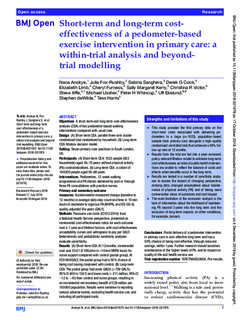Short-term and long-term cost-effectiveness of a pedometer-based exercise intervention in primary care: a within-trial analysis and beyond-trial modelling
Anokye, Nana; Fox-Rushby, Julia; Sanghera, Sabina; Cook, Derek G.; Limb, Elizabeth S.; Furness, Cheryl; Kerry, Sally M.; Victor, Christina R.; Iliffe, Steve; Ussher, Michael; Whincup, Peter H.; Ekelund, Ulf; DeWilde, Stephen; Harris, Tess
Journal article, Peer reviewed
Published version
Permanent lenke
http://hdl.handle.net/11250/2578658Utgivelsesdato
2018Metadata
Vis full innførselSamlinger
- Artikler / Articles [2119]
- Publikasjoner fra Cristin [1107]
Sammendrag
Objectives: A short-term and long-term cost-effectiveness analysis (CEA) of two pedometer-based walking interventions compared with usual care. Design: (A) Short-term CEA: parallel three-arm cluster randomised trial randomised by household. (B) Long-term CEA: Markov decision model. Setting: Seven primary care practices in South London, UK. Participants: (A) Short-term CEA: 1023 people (922 households) aged 45–75 years without physical activity (PA) contraindications. (b) Long-term CEA: a cohort of 100 000 people aged 59–88 years. Interventions: Pedometers, 12-week walking programmes and PA diaries delivered by post or through three PA consultations with practice nurses. Primary and secondary outcome measures: Accelerometer-measured change (baseline to 12 months) in average daily step count and time in 10 min bouts of moderate to vigorous PA (MVPA), and EQ-5D-5L quality-adjusted life-years (QALY). Methods: Resource use costs (£2013/2014) from a National Health Service perspective, presented as incremental cost-effectiveness ratios for each outcome over a 1-year and lifetime horizon, with cost-effectiveness acceptability curves and willingness to pay per QALY. Deterministic and probabilistic sensitivity analyses evaluate uncertainty. Results: (A) Short-term CEA: At 12 months, incremental cost was £3.61 (£109)/min in ≥10 min MVPA bouts for nurse support compared with control (postal group). At £20 000/QALY, the postal group had a 50% chance of being cost saving compared with control. (B) Long-term CEA: The postal group had more QALYs (+759 QALYs, 95% CI 400 to 1247) and lower costs (−£11 million, 95% CI −12 to −10) than control and nurse groups, resulting in an incremental net monetary benefit of £26 million per 100 000 population. Results were sensitive to reporting serious adverse events, excluding health service use, and including all participant costs. Conclusions: Postal delivery of a pedometer intervention in primary care is cost-effective long term and has a 50% chance of being cost-effective, through resource savings, within 1 year. Further research should ascertain maintenance of the higher levels of PA, and its impact on quality of life and health service use. Short-term and long-term cost-effectiveness of a pedometer-based exercise intervention in primary care: a within-trial analysis and beyond-trial modelling
